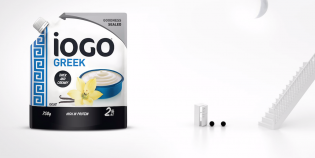On a chilly November day, the dwindling dusk light brings on a flurry of activity on Albert Cuypstraat, home to Amsterdam’s largest street market and the bustling centrepiece of the multicultural, increasingly hip neighourhood known as De Pijp. Vendors rush to pack up the tented, makeshift shops that are erected and deconstructed each day. While the denizens of the Albert Cuyp market retreat into the night, a different kind of transition is nearing its completion just one street over, where Montreal-based agency Sid Lee is preparing to reveal its brand-new Amsterdam office to local media, business leaders and VIP scenesters.
In the minutes before the party begins, employees scurry from one section of the office to another, which, at 550 square metres and sprawling over the equivalent of three shopfronts, is huge by Amsterdam standards. A velvet rope is set up outside to manage the anticipated line. A coat check area, accessible from the street, opens underneath the black facade of the office. There is tension and excitement in the air, and one Sid Lee employee wonders aloud to another whether anyone will show up.
An hour later, this question has been answered emphatically. More than 400 people have piled inside to down champagne, hobnob with fellow attendees and get a taste of the environment created by Sid Lee. It’s an unusual space, to be sure. The centre of the office is actually a retail shop, where clothing, art and even kitchenware, all projects of the Sid Lee Collective—a program developed by the agency to foster creative initiatives that don’t fit client projects—are available for the public to purchase.
Down the left-hand side of this space, a small rise in the wooden floor evolves to become an elevated meeting table in the back of the room, where visitors can view the art on display in Sid Lee’s in-house gallery. Behind the gallery space there is a small café, where patrons can sip coffee or wine and take in the white chalk scribblings on the black walls, images that are refreshed periodically whenever Sid Lee welcomes a new artist contribution. The actual office space, where the agency work gets done, sits on either side of the shop-gallery-cafe trifecta. But even it’s not exactly normal—one meeting room includes a model of an igloo, with a miniature recreation of Sid Lee’s Montreal office inside, while another includes a sofa onto which the phrase “I love your fat ass” has been scribbled.
“More than anything, it’s our physical business card,”says Niels van de Walle, managing partner of Sid Lee Amsterdam, explaining that the experimental design concept was developed to showcase the agency’s cross-disciplinary approach to creativity and commerce.
That Sid Lee chose to leave its European business card in the capital of the Netherlands, as opposed to bigger metropolises such as London or Paris, speaks to Amsterdam’s rising profile in the international business community. For a host of reasons both practical and emotional, the city is poised to break out as one of the continent’s most fashionable creative hubs.
For most members of the advertising community, whether new to Amsterdam or longtime residents, the city’s less tangible qualities provide the most compelling argument for setting up shop here.
“If I had to pick a word for the city, it would be ‘open,’ ” says Philippe Meunier, creative director at Sid Lee. He uses the word to describe Amsterdam’s attitude toward different forms of creative and cultural expression, and believes this openness makes the city an ideal location to experiment with a different kind of office space and attract international talent.
“The first thing for me is that Sid Lee Amsterdam is a talent trap,” says Meunier, suggesting that new business acquisition is secondary to bringing top creative minds into the Sid Lee fold. “There’s a new generation of creatives that doesn’t work in agencies full-time. They have a pack-sack, they have laptops and they’re willing to travel the world to do what they love. Amsterdam is the perfect city to test this new model, because the city is filled with people like that.”
Sid Lee president Jean-François Bouchard backs up Meunier’s assertion that talent recruitment is the main objective for the new office, pointing out that the agency had planned to open in Amsterdam even before it won part of the global account last year for Adidas, whose headquarters are in the city.
In addition to its openness, says Bouchard, Amsterdam shares similar values to the agency’s home city of Montreal. “We saw a fit with this minority culture that’s surrounded by French and Germans and Anglo-Saxons, this tiny culture that’s able to express itself and export its talent.”
With its Amsterdam office, Sid Lee has now officially exported itself to Europe. They may soon be followed by their Canadian competitor Taxi, which plans to open a European office in 2009. While the agency has not announced a formal decision—London is still a possibility—Taxi chairman and co-founder Paul Lavoie shares the Sid Lee team’s attraction to the Dutch city, whose population of 780,000 includes representatives of 174 nationalities.
“Its population is ethnically and culturally diverse, which makes for a great melting pot of ideas—in fact, the atmosphere and values are similar to those in Canada,” says Lavoie in an e-mail. “But there are other very practical reasons as well.”
Lavoie certainly has a point. Business leaders not inclined to swoon over Amsterdam’s creative freedom can still be seduced by a range of tangible incentives. For one thing, the tax environment is extremely friendly in the Netherlands—30% of expatriates’ Dutch income is exempt from taxation, while the top corporate tax rate of 25.5% is lower than those of the U.K., France and Germany. Amsterdam’s Schipol Airport is another significant attraction, a major transportation hub that sits just 15 minutes from the city centre and provides marketers and agencies with quick and easy access to partners in neighbouring countries, as well as daily flights to large North American destinations. What’s more, a market of 350 million consumers sits within 800 miles of Amsterdam.
The Dutch are also famously multilingual, with almost all citizens fluent in English and most capable of conversing in at least one other language in addition to their native tongue. This is particularly appealing to North American companies, which can use the local talent pool to connect with other European markets, but don’t have to learn Dutch to get by.
“One of the things the Dutch have learned is their language sucks, and no one wants to learn it,” jokes van de Walle, who runs Sid Lee’s Amsterdam office along with partner and fellow Netherlands native Harm Sas.
“To establish in Amsterdam is super-easy, because whatever language you speak, you can find your way and find people to help.”
Increasingly, that help is coming from the local government, which has in recent years set several initiatives in motion to brand Amsterdam as one of Europe’s business capitals. In 2004, mayor Job Cohen introduced “I Amsterdam,” a concept created by Dutch ad agency KesselsKramer, as the banner under which the city would market itself going forward. The campaign is a public-private partnership, with multinational companies such as Philips and Heineken providing assistance to Amsterdam’s city council. Some of the organization’s initiatives include the I Amsterdam website, an expat centre where new immigrants can get help with the necessary paperwork, and even a publication, called Proud, that educates business leaders about the economic and cultural advantages of the city.
So far, the branding effort has been successful. In 2007, 34 North American companies set up offices in Amsterdam, compared to 26 the year before and 18% of these new arrivals represented creative, new media and communication fields. That year also culminated with Cohen becoming the first politician to be honoured as “Dutch Advertising Man of the Year” by the local trade publication Marketing Tribune.
As senior area manager, North America, Europe, Middle East and Africa for Amsterdam InBusiness—an offshoot of the I Amsterdam movement created last January—Jane Zoutendijk is responsible for taking the city’s message to businesses abroad. “It doesn’t matter if it’s a marketing and sales office or a European head office—in the end we just want to attract more companies, which will lead to more jobs in the Netherlands,” she says.
Zoutendijk acknowledges the advertising industry is a natural target for a city that prides itself on its creativity, but points out it’s not just about wooing ad agencies. Other kinds of creative enterprises, such as music and post-production, are also on her radar.
Production houses, of course, are necessary to support a vibrant advertising culture, and the proliferation of such shops is just one reason that Peggy Stein, founder of Amsterdam agency Bureau Pindakaas (Peanut Butter, in English), believes her city is on the cusp of a “Golden Age” of advertising. Stein is an enthusiastic supporter of I Amsterdam, and her agency has contributed work to the branding initiative—even though it may eventually result in more competition for her.
“It’s like this. If Taxi’s coming to Amsterdam, there must be a good reason for them to come to Amsterdam,” says Stein. “If nobody’s going to Amsterdam and trying to do business here, then it means there’s nothing here.” In other words, every high-profile company that settles in her backyard makes the city appear that much more palatable to business, increasing the chances that Stein’s client base will grow.
As well as contributing to the branding of Amsterdam, Stein has also done her part to nurture the international talent coveted by agencies like Sid Lee. She doubles as the director of the Amsterdam chapter of the Miami Ad School, and houses the program’s students, 10 to 20 at any given time, in the top floor of Pindakaas’ stately, mansion-like headquarters. As Stein proudly shows off the school’s studio, two students, one from Chicago, the other from Stuttgart, bang away on laptops.
According to Stein, her efforts to brand Amsterdam and educate students are complementary endeavours.
“It means a lot [to have the school there], because [the students] are the ambassadors,” she says. “They go back to their home countries and they can talk about Amsterdam.”
When they talk, chances are that people will listen. Sean Thompson, creative director at 180, made the leap from London three years ago after spending two decades on the U.K. advertising scene, most recently with Weiden + Kennedy (which also has an office in Amsterdam). He admits he had some apprehensions about the move, but says he’s been re-energized by the change in environment. And, like Stein, he can envision an advertising renaissance in his adopted city.
“There are a lot of exciting companies coming to the country now,” he says. “There’s been a sense of, okay, this is really becoming a creative community. Interesting creative people are starting to be very attracted to this place. There are lots of benefits to coming here, financially, and the government’s very good at getting people here.”
Its creative, multinational workforce, good location, favourable business environment and high overall quality of life leave Amsterdam well-positioned to market itself to corporate leaders, agency heads included . With the city now several years into an aggressive branding push that has received support from the local advertising community, there is every reason to believe more individuals and multinational corporations will follow Sid Lee’s lead.
Zoutendijk believes when new arrivals experience Amsterdam, they may never want to leave.
“People who end up here,” she says, “tend to stay.”










